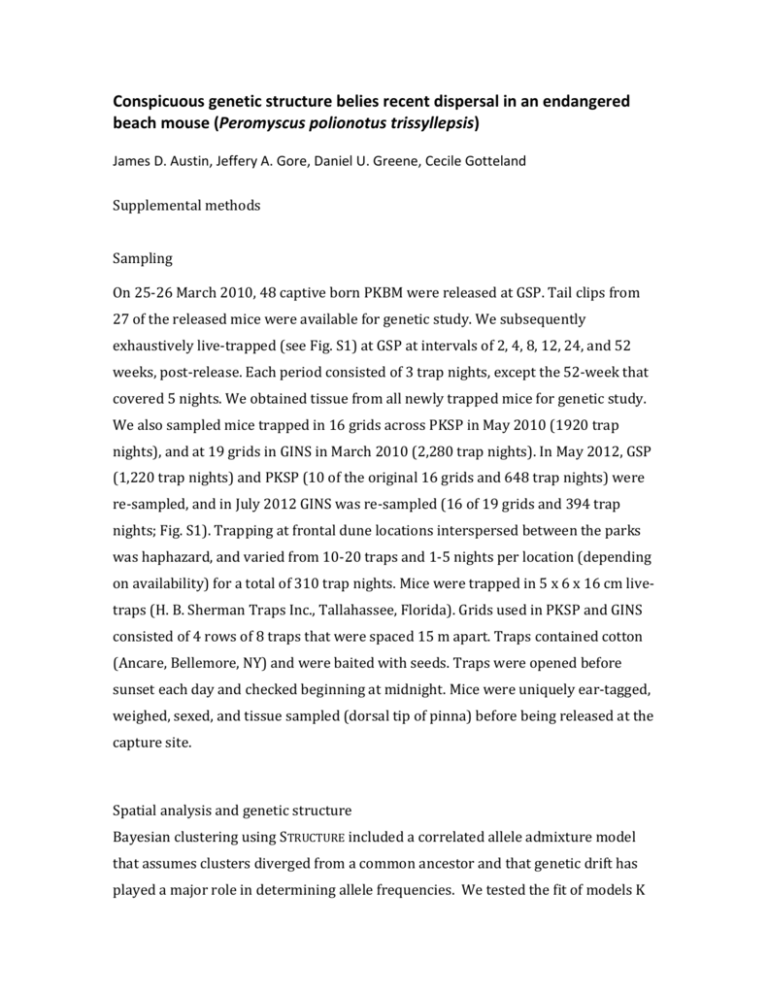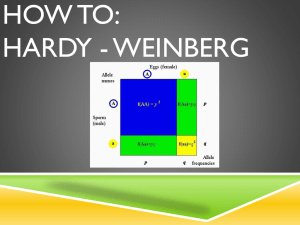Conspicuous genetic structure belies recent dispersal in an
advertisement

Conspicuous genetic structure belies recent dispersal in an endangered beach mouse (Peromyscus polionotus trissyllepsis) James D. Austin, Jeffery A. Gore, Daniel U. Greene, Cecile Gotteland Supplemental methods Sampling On 25-26 March 2010, 48 captive born PKBM were released at GSP. Tail clips from 27 of the released mice were available for genetic study. We subsequently exhaustively live-trapped (see Fig. S1) at GSP at intervals of 2, 4, 8, 12, 24, and 52 weeks, post-release. Each period consisted of 3 trap nights, except the 52-week that covered 5 nights. We obtained tissue from all newly trapped mice for genetic study. We also sampled mice trapped in 16 grids across PKSP in May 2010 (1920 trap nights), and at 19 grids in GINS in March 2010 (2,280 trap nights). In May 2012, GSP (1,220 trap nights) and PKSP (10 of the original 16 grids and 648 trap nights) were re-sampled, and in July 2012 GINS was re-sampled (16 of 19 grids and 394 trap nights; Fig. S1). Trapping at frontal dune locations interspersed between the parks was haphazard, and varied from 10-20 traps and 1-5 nights per location (depending on availability) for a total of 310 trap nights. Mice were trapped in 5 x 6 x 16 cm livetraps (H. B. Sherman Traps Inc., Tallahassee, Florida). Grids used in PKSP and GINS consisted of 4 rows of 8 traps that were spaced 15 m apart. Traps contained cotton (Ancare, Bellemore, NY) and were baited with seeds. Traps were opened before sunset each day and checked beginning at midnight. Mice were uniquely ear-tagged, weighed, sexed, and tissue sampled (dorsal tip of pinna) before being released at the capture site. Spatial analysis and genetic structure Bayesian clustering using STRUCTURE included a correlated allele admixture model that assumes clusters diverged from a common ancestor and that genetic drift has played a major role in determining allele frequencies. We tested the fit of models K = 1 to K = 10. Each run proceeded with 50,000 MCMC iterations as “burn-in”, followed by 100,000 iterations. Each K was examined across 20 independent runs. Results were plotted using StructureHarvester (http://taylor0.biology.ucla.edu/structureHarvester/; accessed Aug. 2013). We replicated these analyses using sample location (GSP, PKSP, and GINS) as a prior using “USEPOPINFO” flag. Runs were post-processed using CLUMPP version 1.1 (Jakobsson and Rosenberg 2007) and Distruct (Rosenberg 2004). Hybrid assignments Before running NEWHYBRID on the empirical data, we took a simulation approach to evaluate the statistical power of our population allele frequencies to detect hybrids between GSP and PKSP, and between PKSP and GINS. To conservatively estimate allele frequencies of residents (more likely to be identical by descent, rather than immigrants or recent immigrate ancestry) at each location we first identified “pure” individuals from each population based on the following criteria: 1) A minimum Q values of 0.98 assignment to either parental population based on the averaged 20 replicates from the best-fit Structure model, and 2) those individuals had no missing genotyped loci. We first simulated new parental populations using the allele frequencies from the pure genotypes selected as above, generating 100 new pure parents for each location by randomly drawing alleles from the empirical frequencies of the pure representatives. From these randomly generated parental genotypes we then simulated 100 each of F1 between neighboring locations and parental populations backcrossed to F1.These genotypes were simulated in HYBRIDLAB version 1.1 (Nielson et al. 2006). Simulated genotypes were then analyzed using NEWHYBRID. We subsequently estimated the power of the allele frequencies at the 16 loci to correctly assign simulated genotypes to their category (pure, F1, backcrossed) as the ratio of correctly identified to the 100 simulated individuals of the same category. Accuracy of assignment to a category was evaluated as the number of correctly identified individuals for a category over the total number of individuals assigned to that category for a given threshold of acceptance of assignment (TQ). We evaluated TQ values of 0.7, 0.8 and 0.9. Supplemental citations Jakobsson M, Rosenberg NA (2007) CLUMPP: a cluster matching and permutation program for dealing with label switching and multimodality in analysis of population structure. Bioinformatics 23:1801–1806 Nielson E, Bach LA, Kotlicki P (2006) Hybridlab (version 1.0): a computer program for generating simulated hybrids from population samples. Mol Ecol Resources 6:971–973 Rosenberg NA (2004) Distruct: a program for the graphical display of population structure. Mol Ecol Notes 4:137–138







